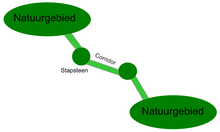Stepping stone concept
The stepping stone concept is a concept of applied nature conservation . " Stepping stones " are an element in promoting the biotope network . It is used, for example, in forestry in order to achieve a higher nature conservation value on the same area in parallel to the management of forests .
definition
The most common definition goes back to the nature conservation biologist Eckhard Jedicke: “Stepping stones between the islands of the large protected areas do not need the size of the area in order to ensure the permanent survival of complete populations . However, they should allow a temporary settlement and also the reproduction in order to be able to form a starting point and an intermediate station for the individual exchange of the large islands ”. Stepping stone biotopes are only one component of the concept. In addition, the biotope network is to be promoted through migration corridors. The existence of large protected areas as refuges and sources of dispersion as well as the permeability of the surrounding landscape is also important. Stepping stone biotopes are (even if not optimal) at least temporary biotopes for the populations and species to be networked. These are not just rest areas or short-term refuges .
meaning
The stepping stone concept is necessary because the agricultural landscape is today more or less hostile to life for most species due to the intensified use. This also applies to species that are still relatively common and widespread today. For this reason, areas with a biotope function should be created or maintained at regular intervals, which enable endangered species to spread on the one hand and subpopulations to allow genetic exchange on the other, i.e. serve to preserve species as a whole. These stepping stones facilitate migrations between areas suitable for species conservation, which otherwise cannot be reached because the species cannot cope with the distance ( anthropogenic intermediate landscape ) between the old and the new area.
Depending on the species to be protected, the stepping stones must have a minimum size, meet different requirements and be offered at species-specific intervals.
implementation
Depending on their role, stepping stone biotopes are usually planned as part of large-scale biotope network planning. There are plans focussed on individual species or groups of species, e.g. B. Mammals, amphibians, reptiles and butterflies, but also flowering plants. There are also more comprehensive approaches that pursue numerous other goals in addition to species protection.
In the concrete implementation in German nature conservation, one rather observes more or less pragmatic, small-scale concepts that are rarely based on the scientific basis of the biology of the target species. The reason is seen in the density of use and the fragmented ownership structure, which make large-scale planning in Germany very difficult.
literature
- Eckhard Jedicke: Biotope Association: Basics and Measures of a New Nature Conservation Strategy (= Ulmer-Fachbuch: Landespflege ), Ulmer, Stuttgart 1990, ISBN 978-3-8001-3311-6 (Dissertation University of Gießen 1990, 254 pages with 104 illustrations and graphic representations and Cards, 24 cm).
- Mergner, Ulrich: The stepping stone concept: nature conservation-integrative forest management protects the diversity of forest types ; Euerbergverlag, Rauhenebrach 2018; ISBN 978-3-00-059743-5 .
Individual evidence
- ↑ Eckhard Jedicke: Biotope network. Basics and measures of a new nature conservation strategy. Eugen Ulmer Verlag, Stuttgart, 1990. ISBN 3-8001-3311-3 , p.71
- ↑ page Biotope network at the BfN ( Memento of the original from August 8, 2013 in the Internet Archive ) Info: The archive link was automatically inserted and not yet checked. Please check the original and archive link according to the instructions and then remove this notice.
- ↑ z. B. Birgit Seifert & Markus Fischer (2008): Habitat networks for dispersal-limited plant species have to be connected at small scale. 6th European Conference on Ecological Restoration (Ghent, Belgium): 1–4.
- ^ Matthias Herrmann & Jutta Knapp (2007): Wildcat Species Protection Program in Saarland. Öko-Log Institute on behalf of the Ministry of the Environment.
- ↑ Sonia Angelone, Christoph Flory, Harald Cigler, Joggi Rieder-Schmid, Aline Wyss, Felix Kienast, Rolf Holderegger (2010): Successful Habitat Networking for Tree Frogs. Quarterly publication of the Natural Research Society in Zurich 155 (3/4): 43–50.
- ↑ Sabine Greßler: Biotope Association for Amphibians: Stepping Stone Biotopes, the New Nature Conservation Strategy. In: Stapfia. Volume 51, pp. 235-249, PDF on ZOBODAT
- ↑ Stephan Kneitz (1999): Settlement dynamics and development of amphibian populations in the agricultural landscape - results of a long-term study near Bonn. Rana Special 3: 21–28.
- ↑ Sigrid Lenz & Almuth Schmidt (2011): Results of a nationwide project to promote the dice snake populations and their habitats. Mertensiella 18: 30-38.
- ↑ Christina von Haaren & Michael Reich (2006): The German way to greenways and habitat networks. Landscape and Urban Planning 76: 7-22.

